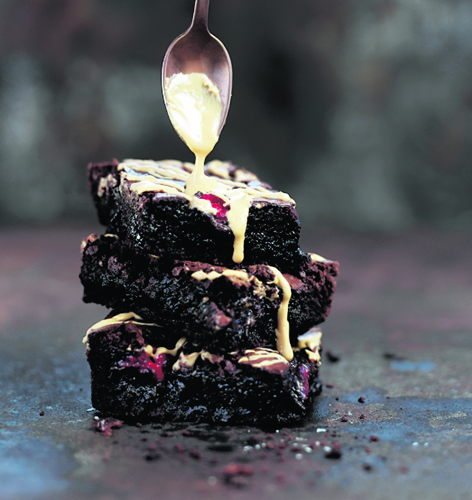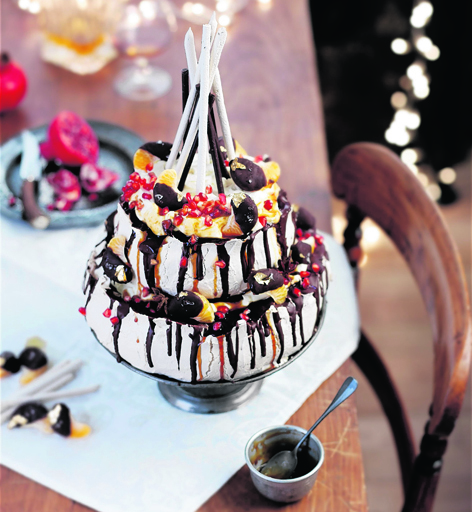Alex Hoffler and Stacey O’Gorman – aka the Meringue Girls – are the first to admit that they don’t do things by halves. “We’re obsessed!” cries a passionate Stacey. From elaborate pavlovas to plush, punk-pink rainbow cakes, the chefs and food stylists – both still in their 20s – have been taking the baking scene by storm with their vibrant and pioneering creations.
They recently developed a whole range of festive meringue flavours, such as mulled wine, mince pie and candy cane, in addition to their classic rainbow cakes. Their latest recipes – brown sugar pavlova, raspberry chocolate traybake and rainbow macarons – are designed to help inspire the nation to try something new in the kitchen and best of all, the girls say even the most amateur of cooks will be capable of perfecting these delicious numbers.
Feeling inspired? Here are three glitzy Meringue Girls recipes to try at home:
TASTE THE RAINBOW MACARONS
MAKES 40-45
FOR THE ALMOND PASTE
200g blanched ground almonds, sieved
200g icing sugar
80g free-range egg whites (about 3 medium eggs)
Food colouring of your choice
FOR THE MERINGUE
200g caster sugar
100g free-range egg white (about 3 medium eggs)
FOR THE BUTTERCREAM
500g caster sugar
250g egg white
500g unsalted butter (room temperature)
Flavouring of your choice
First, make the almond paste. Turn the oven on to 200C. Sieve the almonds into a bowl with the icing sugar and mix until incorporated. With an electric hand whisk or standalone mixer, mix in the egg white to make a thick, smooth paste. Divide the mixture into two bowls, and colour with your chosen food colouring (go slightly darker than you’d like, as the colour will dilute when folded into the white meringue later).
Next, start on the meringue. Pour the caster sugar into a deep roasting dish lined with baking paper and place in the hot oven for seven minutes, until the sugar gets very hot to the touch but doesn’t melt. Meanwhile, whisk the egg whites to a stiff peak, so they are just ready (not over whisked) when the sugar comes out of the oven.
Take the sugar out of the oven and turn oven temperature down to 150C. Then, teaspoon by teaspoon, spoon the hot sugar into the stiff egg whites (still whisking on top speed). Take your time with this to get the meringue as stiff as possible. Continue whisking until the bowl feels cool to the touch (about five to 10 minutes).
Next, divide the meringue mixture into two and, using a wooden spoon, fold the meringue into the two bowls of almond paste, being careful not to knock out the air. Fill a piping bag, with a 1B nozzle, with the mix and pipe out small round mounds (about the size of a 2p coin) on to parchment paper-lined baking trays.
Bash the tray against the worktop about three times to remove air pockets, then let the macarons form a skin (this normally takes about 30 minutes at room temperature). You can tell if it’s ready to go in the oven by running a finger gently across the top of the shells and seeing if it doesn’t stick (it shouldn’t!).
Bake for around 14-16 minutes. To check if they are ready to come out, wiggle a fingertip right to left atop one of the macarons; if the top doesn’t come away from the feet (the bottom of the macarons) then they are good to go.
When they come out of the oven, immediately slide the macarons off the tray on to a cool counter to shock them – otherwise they will stick to the paper when you try to remove them. Let them cool completely before trying to remove from the tray.
While the macaron shells are cooling, start on the buttercream filling. Mix together the egg whites and sugar in a large metal or glass bowl over a saucepan of simmering water. Stir until the sugar crystals have dissolved and mixture is warm to touch (to check this, rub it between two fingers).
Transfer the mixture carefully to the standalone mixer or bowl with a handheld electric mixer, and whisk until stiff peaks form. Keep whisking on full speed until the meringue is at room temperature – and at the same time, while whisking, add the butter in small chunks. Keep whisking until the buttercream resembles the look of whipped cream.
Flavour as you wish. Vanilla is always a safe bet, but there are an abundance of great flavours, including lemon curd, melted chocolate, essences, or pistachio paste. Sandwich each shell with some buttercream and enjoy!
TIP: Unfilled shells can be frozen for up to a month; filled shells can be frozen for up to a week, and will keep well outside the fridge in a sealed container for two to three days.
COCONUT, RASPBERRY AND WHITE CHOCOLATE DRIZZLE BROWNIE
MAKES 16 SQUARES
250g coconut oil
200g dark chocolate (at least 70%), cut into small pieces
70g coconut flour
1tsp gluten-free baking powder
1tsp sea salt for the mixture, plus a little extra to sprinkle on top
80g cocoa powder (at least 70%)
4 large free-range eggs
360g unrefined golden granulated cane sugar
150g raspberries
100g white chocolate (at least 30% cocoa), to drizzle
First, caramelise the white chocolate. Turn the oven on to 110C. Place the pieces of broken up white chocolate into a small oven-proof pot, pan or bowl, and place in the oven for about 40 minutes. Leave the pot to roast slowly, giving it a stir every 10 minutes or so (it may look chalky and lumpy at points, but have faith it will come together with a good stir). Keep roasting the chocolate until it turns a lovely golden colour, similar to smooth peanut butter.
TIP: This step can be done in advance, and the chocolate re-melted over a bain-marie, or in a microwave, when ready to use.
Now make the coconut and raspberry traybake. Heat the oven to 180C and prepare a 25cm x 20cm tin with a little oil and non-stick baking paper. Melt the coconut oil in a saucepan over a medium heat, and when melted, take it off the heat and add the chunks of chocolate. Stir until the chocolate is melted and the mixture is well combined.
Put all the dry ingredients – the coconut flour, baking powder, salt and cocoa powder – into a bowl and mix until they’re well incorporated. Place the eggs in the bowl of a free-standing mixer, or use an electric whisk, and beat until light and creamy.
Alternatively you can do this by hand using a bit of elbow grease! Add the sugar and continue to beat until all is incorporated. Gradually add the melted chocolate mixture to the egg and sugar mixture, whisking the whole time. Gently fold in the dry ingredients, making sure everything is well incorporated, but trying not to knock out any air.
Spoon into the prepared tin and level out, then stud with the fresh raspberries and sprinkle with a little extra sea salt. Bake for about 25 minutes, or until a skewer inserted around the outside of the cake comes out clean. The very middle can still be pretty squidgy, so it’s best to take out when it’s slightly under-baked so that it stays moist. Cool in the tin, and then carefully remove.
Drizzle with the caramelised white chocolate and devour.
CHOCOLATE, POMEGRANATE AND SPICED ORANGE PARTY PAVLOVA
SERVES 15
FOR THE BROWN SUGAR MERINGUE MIXTURE
250g light brown soft sugar
250g golden caster sugar
250g free-range egg whites (about 7-8 eggs)
1tsp of ground cinnamon
FOR THE CREAM FILLING
1 litre double cream
50g icing sugar
CHOCOLATE DIPPED CLEMENTINES
50g dark chocolate, melted
6 clementines, segmented
A touch of sea salt (optional)
FOR THE STICKY SPICED ORANGE DRIZZLE
Juice of 2 oranges, or a splash of readymade orange juice
50g pomegranate molasses
1 cinnamon stick
2 whole star anise
CHOCOLATE DRIPS
100g dark chocolate, to be melted and drizzled over the sides
OPTIONAL DECORATIONS
Cinnamon meringue sticks
Chocolate orange matchmakers
Edible gold leaf
Pomegranate seeds
First, make the brown sugar meringue mixture. Prepare two flat baking trays with non-stick baking paper for the pavlova, and draw two circles on the baking paper as a guide – 13cm and 18cm in diameter. Line another flat baking tray with non-stick paper for the decorative meringue sticks. Preheat the oven to 200C, and line a deep baking tray with baking parchment.
Then pour in the brown sugar and the golden caster sugar and heat it in the oven for 5 to 7 minutes. The brown sugar caramelises quickly, so bash and stir with a wooden spoon every couple of minutes to stop it from clumping up. Heating the sugar helps to create a glossy, stable mixture.
Pour the egg whites into a mixer and whisk them slowly, allowing small stabilising bubbles to form, then increase the speed until the egg whites form stiff peaks. Don’t let them over whisk! Take the sugar out of the oven, and turn oven down to 100C. With your mixer on full speed, very slowly, spoon by spoon, add the hot sugar into the beaten egg whites, making sure the mixture comes back up to stiff peaks after each addition of sugar. Don’t add any large lumps of sugar that may have caramelised.
Once all of the sugar has been added, add in the ground cinnamon and continue to whisk on full speed until a smooth, stiff and glossy mixture has been achieved. Continue to whisk for at least five minutes once the sugar has incorporated.
TIP: If the mixture feels gritty between your fingers, keep whisking at full speed until it has dissolved.
Working quickly, before the meringue begins to deflate, spoon the meringue mixture into the pre-drawn circles, and carefully shape smooth, tall nests with a palette knife. Use the back of a spoon to create a deep well. Bake low and slow in the oven for about four hours. When cooked, the meringue should have a firm base and come away from the baking paper. Set aside to cool. This can be made up to four days in advance and kept in a cool, dry place.
Next, make the meringue sticks. With any spare meringue mixture, fill up a disposable piping bag, and cut a small 5p-sized hole in the tip. Use this to pipe long sticks on to a baking tray. Pop these in the oven with the pavlova, but take them out after an hour and a half. After that, focus on the spiced pomegranate and orange drizzle.
Put the orange juice and spices in a small saucepan and heat to infuse the spices and slightly reduce – keep an eye on it, as it reduces (and burns) fast. When it’s nice and spicy, remove from the heat and add the pomegranate molasses to make a sticky sour and spiced syrup. To make the chocolate-dipped clementines, dip the segmented clementines in melted chocolate, and lay on a piece of baking paper. Sprinkle with a little sea salt and allow to harden.
To serve, place the largest pavlova shell in the centre of a serving platter. Drizzle with melted chocolate, letting it drip down the sides of the nest. Whip the double cream, adding icing sugar until soft peaks form, and slather this over the top.
Place on top of this the smaller-sized pavlova, and decorate the chocolate drips and cream too. Let your inner baker get creative with the chocolate-dipped clementines, pomegranate seeds, cinnamon meringue sticks, orange matchstick makers and gold leaf – then give it a final flourish with the sticky spiced glaze.



